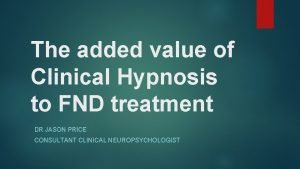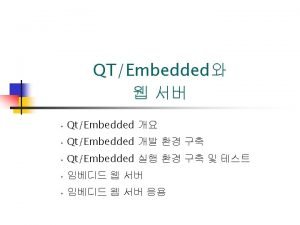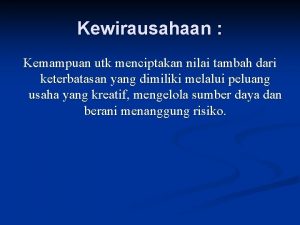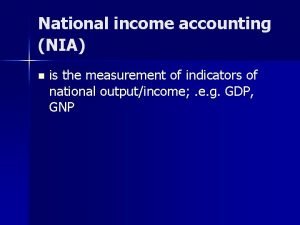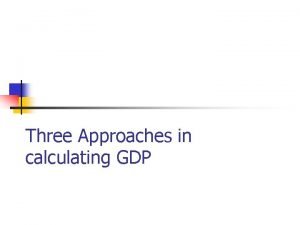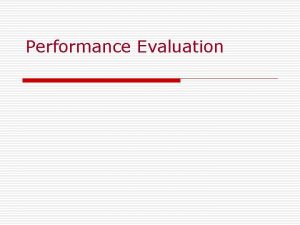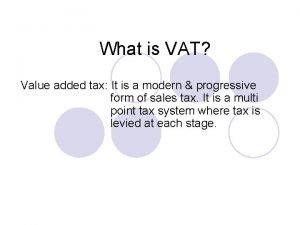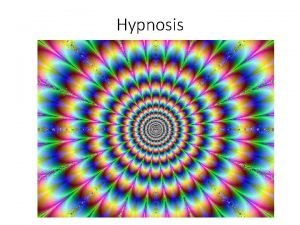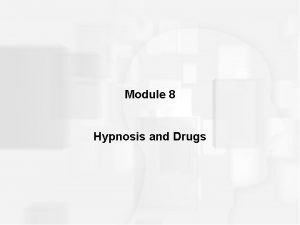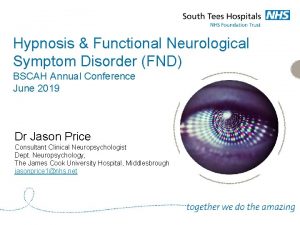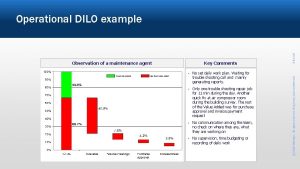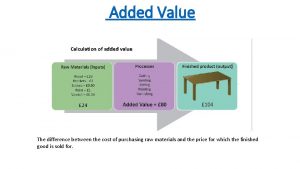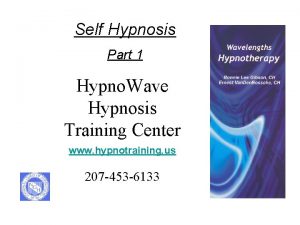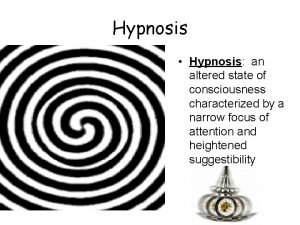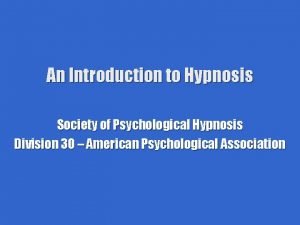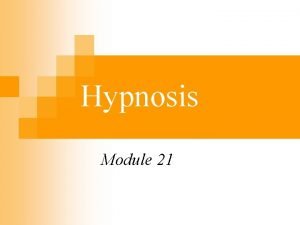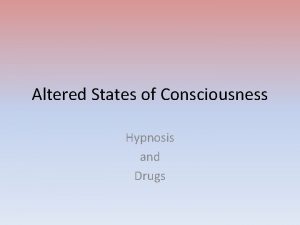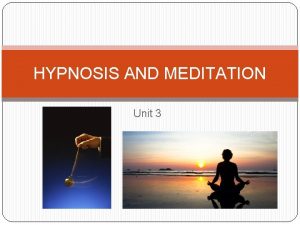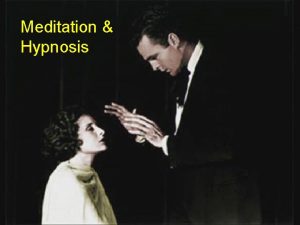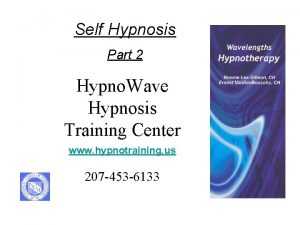The added value of Clinical Hypnosis to FND





















- Slides: 21

The added value of Clinical Hypnosis to FND treatment DR JASON PRICE CONSULTANT CLINICAL NEUROPSYCHOLOGIST

What is Hypnosis? Hypnosis aims to inculcate a controlled, volitional dissociative, yet focussed state (trance) – based upon controlled attentional processes via suggestion Trance states are everyday occurrences (e. g. daydreaming) Clinical Hypnosis as an adjunct to psychological and physical therapies (please note Physio, OT, SLT, Neurology, Nurse colleagues!) But can have a more direct role in treating FND, due to the similar underlying neurocognitive mechanisms involved in both

“Hypnosis produces a highly focussed, absorbed attentional state that minimizes competing thoughts and sensations” Oakley, D. & Halligan, P. (2013)

Evidence Large evidence base: IBS Pain Anxiety/Stress Enhances effects of traditional psychological therapies Strong f. MRI & EEG evidence of altered neural patterns under hypnosis

FAQs Is it mind control? NO The Hypnotist is just like a Tour Guide…. you can choose to follow and listen…. or you can choose to do your own thing…or nothing at all Can anyone be hypnotized? Most people to some degree Smaller proportion are ‘highly hypnotizable’

FAQs: Is it dangerous? Lot safer than medications Most people find it a pleasant experience You will NOT accidentally stay in a hypnotic trance As safe as any other psychological intervention, but could trigger an abreaction, less controlled dissociation, FND symptom

Oh, and you are NOT put into a deep sleep! Just a focussed attentional state!

Dissociation & FND DISSOCIATION as a core mechanism in FND: Function (why it happens) AND Mechanism (how it happens) As a result of altered attentional processing ‘‘a disruption and/or discontinuity in the normal integration of consciousness, memory, identity, emotion, perception, body representation, motor control, and behavior’’ (DSM; American Psychiatric Association).

So, why will hypnosis help with FND? Hypnosis & FND share the same primary process: DISSOCIATION Works on the mechanism of FND (e. g. dissociation/attention), not necessarily the cause or function – therefore has wide applicability across all FND (unlike otherapies) and don’t need to identify trigger Can create and remove functional symptoms in experimental conditions

Hypnosis & Mindfulness – attention training Attention Spectrum Hypnosis Mindfulness De-focus through focus Focus through de-focus Dissociation guided focus (‘suggestion’) (Guided) self-awareness; connectedness

Hypnosis Recreates Functional Amnesia Jamieson, G. A. et al (2017): Hypnotic amnesia for previously seen faces EEG; Alpha changes; N=24 Top down control processes modulate lower level responses Process ‘protected’ from incongruent (accurate) feedback from internal/external information Alpha changes consistent with decreased (i. e. inhibited) activity in face processing cortex in HH in amnesic condition Reversed when removed from suggestion!

Hypnosis treatments for FND Moene et al. (2003): Hypnosis RCT for motor conversion disorder; , N=44 Manualised, 30 10 weekly 1 hour sessions; 1 preparatory session; fidelity assessments minutes self-hypnosis each day Direct suggestions for symptoms alleviation; emotional expression/insight direction Significant improvement on behavioural symptoms at end of therapy and maintained at 6 month follow-up No significant differences on general measures of psychological pathology (SCL-90) [working on mechanism directly]

Hypnosis for FND ‘Basic’: Rapid relaxation Advanced: Positive Ideo-motor suggestions: Enhancement of functioning distraction/attentional re- Alteration of functioning focussing e. g. : ‘safe-place’ pain modulation Cognitive suggestions: Pre-morbid Regression/imagery to improve functioning Developing rapid awareness of different emotional, physical and cognitive states Developing ‘resources states’ Recreating Dissociative experiences and teaching control

A typical Hypnosis session Develop an individualised hypnotic script: Based upon aims of session (e. g. relaxation, ‘safe place’, symptom focussed, resource development, symptom modulation; symptom creation and removal) ‘Induction’ – usually body scan/muscle relaxation suggestions (need to be aware of any contra-indications which might cause distress) ‘Deepeners’ – (e. g. suggestions for ideomotor imagery, deeper relaxation; going through doors, counting, intensity dial) Imagery; suggestions (direct & indirect) & post hypnotic suggestions Exit HYPNOSIS CAN TRIGGER DISSOCIATIVE OR CONVERSION SYMPTOMS; TRAUMATIC IMAGES; ABREACTION

Hypnotic strategies for working with FND Moene et al. (2008); adapted from Deeley, Q. (2016) Motor FND: Direct attention upon affected limb; encourage awareness of sensation/movement; positively reinforce Direct attention upon non-affected limb; encourage awareness of sensation/movement; positively reinforce; suggest that these sensations will flow/transfer to the unaffected limb (hypnotic variation of mirror box intervention!)

Hypnotic strategies for working with FND Moene et al. (2008); adapted from Deeley, Q. (2016) Motor FND: Imagination of normal functioning in the past (used in successful mental imagery retraining in stroke); stimulating pre-motor circuits by strong, memory reinforced imagery Relaxation: [be creative!] general relaxation; specific relaxation of target areas (e. g. of functional spasticity) Imagination: using imagery to increase function in novel ways (e. g. rolling a ball with foot, balloon in hand) Functional tremor/shaking: ‘Letting go’ – relaxing, not resisting, shaking off (tensing increases symptoms) Incongruent imagery (e. g. imagining limbs as heavy an flaccid to reduce movement – similar to HRT in Tourette’s intervention)

Hypnotic strategies for working with FND Moene et al. (2008); adapted from Deeley, Q. (2016) Dissociative NES: Recreating or recalling dissociative state/event to gain mastery (perhaps using grounding techniques or attentional control) Facilitating awareness of trauma images to gain mastery (e. g. desensitization, imagery restructuring, resource overlay; linking past trauma imagery with current symptoms – EMDR type procedures) Altering perception of prodromal symptoms

Conclusions Hypnosis has reliable, demonstrable cognitive neuropsychological properties as evidenced in cognitive experiments as well as imaging studies Works at a primary process level with Dissociation Hypnosis is already used as part of other ‘mainstream’ psychological interventions & can be used with co-morbid conditions such as PAIN & IBS, ‘stress’ (via relaxation)

Conclusions Works on mechanism, so don’t need to worry so much about cause Preliminary evidence of effectiveness in treating FND Can be used by variety of Helthcare professionals, not just Psychologists/Psychiatrists (Physio, OT, SALT, Neurologists) Empowering – self hypnosis Need larger, RCTs to get it ‘on the main stage’

If you want to try hypnosis… Try to find a practitioner who is also a healthcare professional – in the UK, hypnotherapist is not a statutory regulated title, therefore many hypnotherapists do not have a legally binding professional Code of Conduct – They might also lack necessary clinical skills to deal with issues such as anxiety, depression or abreactions. Find a Physician, Registered Psychologist, Psychiatrist, Nurse, OT, Physio, SLT will give you this safety from their parent profession. “conducted only by properly trained and credentialed healthcare professionals (e. g. Psychologists)…who are working within the limits of their professional expertise. ” APA Div. 30, Society of Psychological Hypnosis Try to find a practitioner who has experience of working with FND if you are wanting to work directly on the symptoms

Hypnosis References People to Google!: http: //neurodigest. co. uk/wpcontent/uploads/2020/04/Neurodigest-issue 5 -page-12 -14. pdf Devin Terhune David Oakley Peter Halligan Quinton Deeley John F. Kihlstrom Peter Naish Irving Kirsch Steven Jay Lynn Richard J Brown Michael Heap
 Fnd 16진수
Fnd 16진수 Hex fnd
Hex fnd Hypno fnd
Hypno fnd Fnd
Fnd Qt fnd
Qt fnd Fnd
Fnd Avr block diagram
Avr block diagram Ano ang expenditure approach
Ano ang expenditure approach Value added skills
Value added skills Value added approach formula
Value added approach formula Activity based costing ppt
Activity based costing ppt How to calculate gdp
How to calculate gdp Value-added agriculture
Value-added agriculture What oo
What oo Value addition of tea
Value addition of tea Value added approach formula
Value added approach formula Benefits of vat
Benefits of vat Brand is the added value endowed to products and services
Brand is the added value endowed to products and services Language
Language Value added elements
Value added elements Value added
Value added Eva finance
Eva finance


